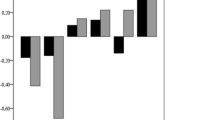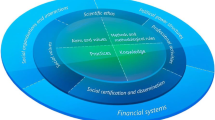Abstract
A concern commonly raised in literature and in media relates to the declining proportions of students who enter and remain in the ‘science pipeline’, and whether many countries, including Australia and New Zealand, have enough budding scientists to fill research and industry positions in the coming years. In addition, there is concern that insufficient numbers of students continue in science to ensure an informed, scientifically literate citizenry. The aim of the research presented in this paper was to survey current Australian and New Zealand scientists to explore their reasons for choosing to study science. An online survey was conducted via a link to SurveyGizmo. The data presented are from 726 respondents who answered 22 forced-choice items and an open-ended question about the reasons they chose to study science. The quantitative data were analysed using t tests and analyses of variance followed by Duncan’s multiple range tests, and the qualitative data were analysed thematically. The quantitative data showed that the main reasons scientists reported choosing to study science were because they were interested in science and because they were good at science. Secondary school science classes and one particular science teacher also were found to be important factors. Of much less importance were the prestige of science and financial considerations. The qualitative data expanded on these findings and showed that passion for science and/or curiosity about the world were important factors and also highlighted the importance of recreational pursuits, such as camping when a child. In the words of one respondent, ‘People don’t go into science for the money and glory. It’s passion for knowledge and science that always attracted me to the field’.





Similar content being viewed by others
References
Abrahams, I. (2009). Does practical work really motivate? A study of the affective value of practical work in secondary school science. International Journal of Science Education, 31(17), 2335–2353.
Adamuti-Trache, M., & Andres, L. (2008). Embarking on and persisting in scientific fields of study: cultural capital, gender, and curriculum along the science pipeline. International Journal of Science Education, 30(12), 1557–1584.
Australian Bureau of Statistics (2011). Education and work, Australia, May 2011. cat. No. 6227.0. Available from http://www.abs.gov.au. Accessed 20 June 2012
Barmby, P., Kind, P. M., & Jones, K. (2008). Examining changing attitudes in secondary school science. International Journal of Science Education, 30(8), 1075–1093.
Bøe, M. V., Henriksen, E. K., Lyons, T., & Schreiner, C. (2011). Participation in science and technology: young people’s achievement related choices in late-modern societies. Studies in Science Education, 47(1), 37–72.
Bolstad, R., & Hipkins, R. (2008). Seeing yourself in science: the importance of the middle school years (Report prepared for the Royal Society of New Zealand). Wellington, New Zealand: New Zealand Council for educational Research.
Bull, A., Gilbert, J., Barwick, H., Hipkins, R., & Baker, R. (2010). Inspired by science: a paper commissioned by the Royal Society and the Prime Minister’s Chief Science Advisor. Wellington, New Zealand: New Zealand Council for Educational Research.
Bybee, R., & McCrae, B. (2011). Scientific literacy and student attitudes: perspectives from PISA 2006 science. International Journal of Science Education, 33(1), 7–26.
Caygill, R. (2008). Science: Trends in Year 5 science achievement 1994 to 2006. Wellington, New Zealand: Ministry of Education, New Zealand.
Cohen, L., Manion, L., & Morrison, K. (2011). Research methods in education (7th ed.). Abingdon, UK: Routledge.
Duncan, D. B. (1955). Multiple range and multiple F tests. Biometrics, 11, 1–42.
Eccles, J. (2009). Who am I and what am I going to do with my life? Personal and collective identities as motivators of action. Educational Psychologist, 44(2), 78–89.
Education and Training Committee (ETC.) Parliament of Victoria. (2006). Inquiry into the promotion of mathematics and science education. Final Report. Melbourne, Australia: Victorian Government Printer.
Commission, E. (2004). Europe needs More Scientists: Report by the High Level Group on Increasing Human Resources for Science and Technology. Brussels: European Commission.
Fensham, P. J. (2008). Science education policy-making: Eleven emerging issues. Paris: UNESCO.
Fowler, F. J. (2009). Survey research methods (4th ed.). Thousand Oaks, CA: SAGE.
Garnett, R. (2003). Reaching all Australians. Kingston, Australia: National Reference Group.
Goodrum, D., Hackling, M., & Rennie, L. (2001). The status and quality of teaching and learning of science in Australian schools: a research report. Canberra: Department of Education, Training and Youth affairs.
HM Treasury. (2006). Science and Innovation investment Framework: next steps. London: HMSO.
Jacobs, J. E. (2005). Twenty-five years of research on gender and ethnic differences in math and science career choices: What have we learned? New Directions for Child and Adolescent Development, 110, 85–94.
Hoachlander, G., & Yanofsky, D. (2011). Making STEM real. Educational Leadership, 68(6), 60–65.
Kim, M., & Song, J. (2009). The effects of dichotomous attitudes toward science on interest and conceptual understanding in physics. International Journal of Science Education, 31(7), 2385–2409.
Lee, Y.-J. (2012). Identity-based research in science education. In B. J. Fraser, K. G. Tobin, & C. J. McRobbie (Eds.), Second international handbook of science education (pp. 35–45). Dordrecht, The Netherlands: Springer.
Lucas, K. (2004, June). A study of the influence of the Smart Moves presentation on students. A report prepared for Questacon: The National Science and Technology Centre, King Edward Terrace, Parkes, Canberra, Australia
Lunn, M., & Noble, A. (2008). Re-visioning science ‘Love and passion in the scientific imagination’: art and science. International Journal of Science Education, 30(6), 793–805.
Maltese, A. V., & Tai, R. H. (2010). Eyeballs in the fridge: sources of early interest in science. International Journal of Science Education, 32(5), 669–685.
Masnick, A. M., Valenti, S. S., Cox, B. D., & Osman, C. J. (2010). A multidimensional scaling analysis of students’ attitudes about science careers. International Journal of Science Education, 32(5), 653–667.
Millar, R., & Osborne, J. (2001). Beyond 2000: science education for the future. London: King’s College London.
National Academy of Sciences: Committee on Science Engineering and Public Policy. (2005). Rising above the gathering storm: energizing and employing America for a brighter economic future. Washington, DC: National Academy Sciences.
National Commission on Mathematics and Science Teaching for the 21st Century. (2000). Before It's Too Late. Washington, DC: Department of Education.
OECD Global Science Forum. (2006). Evolution of student interest in science and technology studies: Policy report. Available from http://www.oecd.org/dataoecd/16/30/36645825.pdf. Accessed 3 September 2006
Office of the Chief Scientist. (2012). Health of Australian science. Canberra, ACT: Commonwealth of Australia. Available from www.chiefscientist.gov.au
Osborne, J., & Dillon, J. (2007). Research on learning in informal contexts: advancing the field? International Journal of Science Education, 29(12), 1441–1445.
Osborne, J., Simon, S., & Collins, S. (2003). Attitudes toward science: a review of the literature and its implications. International Journal of Science Education, 25(9), 1049–1079.
Pike, A. G., & Dunne, M. (2011). Student reflections on choosing to study science post-16. Cultural Studies of Science Education, 6, 485–500.
Rennie, L. J. (2007). Learning science outside of school. In S. K. Abell & N. G. Lederman (Eds.), Handbook of research on science education (pp. 125–167). Mahwah, NJ: Lawrence Erlbaum.
Riegle-Crumb, C., Moore, C., & Ramos-Wada, A. (2011). Who wants to have a career in science or math? Exploring adolescents’ future aspirations by gender and race/ethnicity. Science Education, 95(3), 458–476.
Rowbotham, J. (2012, Wednesday January 18). Gillard’s chief scientists says learning crisis a ‘no-brainer’. The Australian Higher Education Supplement, pp.36–37.
Schoon, I. (2001). Teenage job aspirations and career attainment in adulthood: a 17-year follow-up study of teenagers who aspired to become scientists, health professionals, or engineers. International Journal of Behavioural Development, 25(2), 124–132.
Sonnert, G. (2009). Parents who influence their children to become scientists: effects of gender and parental education. Social Studies of Science, 39(6), 927–941.
Stocklmayer, S. M., Rennie, L. J., & Gilbert, J. K. (2010). The roles of the formal and informal sectors in the provision of effective science education. Studies in Science Education, 46, 1–44.
Tai, R. H., Liu, C. Q., Maltese, A. V., & Fan, X. (2006). Planning early for careers in science. Science, 312, 1143–1144.
Tal, T. (2012). Out-of-school: learning experiences, teaching and students’ learning. In B. J. Fraser, K. G. Tobin, & C. J. McRobbie (Eds.), Second international handbook of science education (pp. 1109–1122). Dordrecht, The Netherlands: Springer.
Telford, M., & Caygill, R. (2007). PISA 2006 How ready are our 15-year-olds for tomorrow’s world? Wellington, New Zealand: Ministry of Education.
Thomson, S., & De Bortoli, L. (2009). Exploring scientific literacy: how Australia measures up: The PISA 2006 survey of students’ scientific, reading and mathematical literacy skills. Camberwell, Victoria: ACER Press.
Thomson, S., De Bortoli, L., Nicholas, M., Hillman, K., & Buckley, S. (2011). Challenges for Australian education: results from PISA 2009. Camberwell, Victoria: ACER Press.
Thomson, S., Wernert, N., Underwood, C., & Nicholas, M. (2007). TIMSS 07: taking a closer look at mathematics and science in Australia. Camberwell, Victoria: ACER Press.
Tytler, R., & Osborne, J. (2012). Student attitudes and aspirations toward science. In B. J. Fraser, K. G. Tobin, & C. J. McRobbie (Eds.), Second international handbook of science education (pp. 597–626). Dordrecht, The Netherlands: Springer.
Universities Australia (2012). STEM and NonSTEM First Year Students. Canberra: Australia. Department of Industry, Innovation, Science, Research and Tertiary Education. Available from www.universitiesaustralia.edu.au. Accessed 25 February 2012
Venville, G., Oliver, M., Longnecker, N., & Rennie, L. (2010). Selecting science subjects: why students do, why they can’t! Teaching Science, 56(3), 19–26.
Wellington, J. (1990). Formal and informal learning in science: the role of interactive science centres. Physics Education, 25, 247–252.
Young, M. (2008). From constructivism to realism in the sociology of the curriculum. In G. J. Kelly, A. Luke, & J. Green (Vol. Eds.), Review of Research in Education: What Counts as Knowledge in Educational Settings (Vol 32, pp. 1–28). Thousand Oaks, CA: Sage.
Acknowledgments
The research presented in this paper was supported by a Linkage grant from the Australian Research Council (LP0989409), with Scitech and Chevron as industry partners. The views expressed are those of the authors.
Author information
Authors and Affiliations
Corresponding author
Appendix 1
Appendix 1
Rights and permissions
About this article
Cite this article
Venville, G., Rennie, L., Hanbury, C. et al. Scientists Reflect on Why They Chose to Study Science. Res Sci Educ 43, 2207–2233 (2013). https://doi.org/10.1007/s11165-013-9352-3
Published:
Issue Date:
DOI: https://doi.org/10.1007/s11165-013-9352-3




